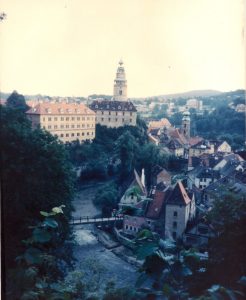 John M. Edwards checks out the new Czech Republic’s “Cesky Krumlov,” where real “Bohemians” come from. . . .
John M. Edwards checks out the new Czech Republic’s “Cesky Krumlov,” where real “Bohemians” come from. . . .
On my first visit to communist Czechoslovakia in 1989 (right before the Velvet Revolution), I drove down in my rented and probably bugged Skoda car to the legendary Bohemian locus of magnetic Cesky Krumlov, the most stylish picturesque village in the country.
I realized to be truly “Bohemian,” you had to actually be from the geographical region labeled BOHEMIA on the map. This charmed historical backwater in a jagged-jigsaw-puzzle-shaped demesne, filled with dissidents, drifters, and dreamers, surely fit the bill.
In fact, Bohemian now means “vagabond,” which includes dirtbag travelers, without being at all pejorative.
The unconventional “boho” inhabitants (who have lent their name as derivatory slang to artists, intellectuals, slackers, and flaneurs across Die Welt), were then only nominally “socialist.” They instead practiced a severe form of ultra-capitalism called the “black market,” which back then worked wonderfully well for us all.
“Deutschmarks?” the Bohemian in a blue suit and no tie sidled up to me.
“Aren’t you afraid of getting caught by the secret police?” I countered.
“Nein, nein, nicht Stasi!” His insistence on speaking German, a language I did not know, was evidence that he did not believe that I was really American. Perhaps I was a spy from East Germany?
He scribbled the amount of Czech koruna per Deutschmark in a loopy Arabic script wherein all the 7s looked like crosses.
“No, dollars!” I reemphasized.
He penned down an even better deal (no: staggering).
I quickly removed a Jackson from my special belt with its secret zippered lining, feeling a little like an international art smuggler. The amateur kapitalist snatched the Jackson and dumped an enormous wad of (worthless) Czech crowns into my hand, then made a mad run for it.
It was not exactly the deal we had agreed upon. But still the amount was suitable to act like a Holy Roman Emporer in a luxus hotel for a couple of days at least. The transaction was a stubborn reminder that unorthodoxy (artistic or otherwise) is endemic to historic loci no matter who rules.
Flush in illegal crowns, I nevertheless ended up grounded at the “Communist Party Workers Hostel,” since Western capitalists traveling independently here had to register every night with the police. With the window open in the dorm room I shared with absolutely no other guests, I breathed in the pleasant smell of damp and disinfectant while exclamation points dropped out of the atmosphere onto the cobblestones, luring me like a lullabye. I soon said, “Guten Nacht.”
And that’s when the “brainwashing” began. . . .
* * *
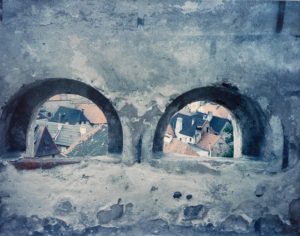 Recently, I revisited Cesky Krumlov to celebrate the new millenium (over a decade late), wondering if it had changed much with the advent of ultra-capitalist reform and frei democratization (you can even still smoke in kavarna [wine bars] and pivnice [beer halls]), featuring a tourismo blitzkrieg of mostly Teutonic trampers (who all call the city “Krumau”). Tourism, in fact, now makes the city swell with more foreigners than locals, who now number less than 20,000 souls.
Recently, I revisited Cesky Krumlov to celebrate the new millenium (over a decade late), wondering if it had changed much with the advent of ultra-capitalist reform and frei democratization (you can even still smoke in kavarna [wine bars] and pivnice [beer halls]), featuring a tourismo blitzkrieg of mostly Teutonic trampers (who all call the city “Krumau”). Tourism, in fact, now makes the city swell with more foreigners than locals, who now number less than 20,000 souls.
After the fifteen-minute walk from the train station to the main square, I once again stumbled like a stunned time traveler upon serendipity, my Rockports scraping the uneven overbitten cobbles of this 750-year-old masterpiece of Habsburgian architectural opulence. With everywhere the awesome rush of the Vltava river, immortalized by Czech nationalist composer Smetana in Ma Vlast (My Country), I fell under a spell.
I wandered like the pale somnambulist played by Conrad Veight in the German Expressionist classic film “The Cabinet of Dr. Caligari” into a nice pensiony called “Pension Jan” on Pod Vyhlidkou 232, where I had to settle for a double for CZK 650. After wrapping myself like mummified remains in a Band-Aid-colored comforter, I caught a quick nap before tackling the tarmac.
Awake only an hour later, I set off to sightsee, making my way to the buzzing town square. Ignoring the overcrowded Infocentrum, I made a beeline to one of my favorite hives—now, let’s see, where was it? Oops, wrong ulice!
* * *
Departing the inner sanctum of the so-called Communist Party Workers Hostel way abck when, I wandered the quiet streets until I almost bumped into a fellow tourist with John Lennon glasses and a leather daypack.
“Oh, hullo! Sorry!”
“Ah, a Brit!” I said, noticing the accent.
“Yus, from Nottinghamshire.”
“Like, where Robin Hood is from?” I asked naively.
“Not far from Sherwood Forest, yus. . . .”
“I’m from New York,” I prouded.
“Really, are you a Communist?”
“No.”
“I am. That’s why I’m here.”
I began to wonder if he really was from England; there was something a little dodgy about his accent.
“This place will nuvur change. It’s fantastic, but please watch out for all the ‘Travellers’!”
“What do you mean by that?” I said peevishly. “I’m a traveler, aren’t you—or do you mean I’m a ‘backpacker,’ while you are a ‘tourist?’”
He explained away the misunderstanding, informing me that in Great Britain, “traveller” is just a euphemism for “homeless chap”—and we both exploded with laughter after.
Later, I realized he had been referring vaguely to the caravan Gypsies (known now as the “Rom”), who seemed to me like colorful beings out of Universal Pictures—a different kind of “Bohemian,” with no nation to call headquarters, a name dredged up from North Africa (derivation from “Egyptian”), and a probable origin among the Untouchables of the Indian subcontinent. Passing by a dive bar, I was eventually attracted by the wild strains of frenzied violins.
* * *
There in the recent past, the “Kafkaesque” Castle complex, rising up through a labyrinth of red roofs, diverted my attention. I walked toward it on Latran Ulice, then through the red iron gates, across the Bear Moat, and into a second courtyard featuring the entrance—but with the line being way long, I decided to bag it.
Yay! Lunch time! Yay!
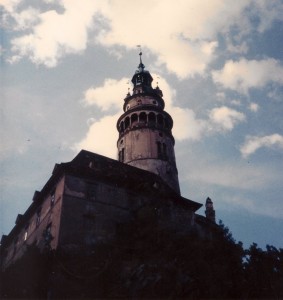 Near the Budejovicka Gate at a must-go victuals venue called Hospoda 99, I took a seat on the sunlit terrace enjoying the al fresco atmosphere (that’s eurospeak for “outside”) and ordered a pivo: Staropramen. Which many Czechs prefer over Pilsner-Urquell and Budvar, probably the most popular export brands of pilsner, a Czech invention. Then I ordered some roast pork with peas, a longtime staple for both the Bolsheviks and the Bourgeoisie.
Near the Budejovicka Gate at a must-go victuals venue called Hospoda 99, I took a seat on the sunlit terrace enjoying the al fresco atmosphere (that’s eurospeak for “outside”) and ordered a pivo: Staropramen. Which many Czechs prefer over Pilsner-Urquell and Budvar, probably the most popular export brands of pilsner, a Czech invention. Then I ordered some roast pork with peas, a longtime staple for both the Bolsheviks and the Bourgeoisie.
However, if you are a difficult vegan, you can amble over to “Laibon” on Parkan Ulice, an actual vegetarian haven and tea house filled with fragrant new hippies wearing Phish concert T-shirts. (Which I didn’t mind, since I had played in a high school garage band with Page McConnell, now the keyboardist of Phish. I had also, alas, turned down a job as bassist for STP [The Stone Temple Pilots] way back when before they were big.)
Later, at a joint called the “Horror Bar,” on Masna Ulice, I sucked on a skoumavky, a little test tube filled with blood-red liquor. What? I don’t know. Suddenly realizing I was surrounded by Bohemian vampires, I immediately asked in Czech for the check please (“Prosim”), then thanked them (“Dekuju”), before bolting like astronomer Tycho Brahe in a brouhaha of thunder and lightning.
Outside in the rancid rain I met a fellow American backpacker who mentioned he was here looking to start an “Import-Export” business (an international euphemism for “chronic unemployment”) and was staying at the “Hostel Skippy” for only 250 crowns.
“Greeaaat!” I elongated like Tony the Tiger. No thanks, pal.
Unfortunately, I could tell he thought I was making fun of him (and his fanny pack). But actually I was just in a hurry to leave, because, you see, this was not to be a long sojourn down memory lane—but just an overnighter.
And there was just one more thing I really wanted to see: The Egon Schiele Centrum Museum. One of my favorite artists, Schiele set up his easel for a short time in this little “willage” while working on his famous “Dead Town” series and naughty female nudes. Incidentally, angry pitchfork-wielding villagers and cuckolds drove out poor Egon from the town because they viewed the revolutionary genius as a “pornographer.”
Though much had changed in this UNESCO World Heritage site, especially the revivified “kaffe klatches” for all the emerging artists, I in some ways, despite all the new tourists, wearing counterfeit Levi’s and Ché T-shirts, liked it even better.
Still, I’m glad I went while it was still behind the Iron Curtain.
Even though festive Cesky Krumlov has indeed changed, the real “Bohemians” (from which Left Bank Parisians and East Village Hipsters derive their mantra) remain pretty much the same: defiant but friendly, always independent but not fiercely so.
But remember: Here the so-called Cold War was always fought not with propaganda, but with a little penicillin!


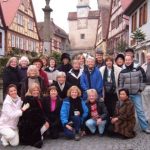
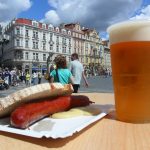



Thanks John – I enjoyed reading your interesting piece!